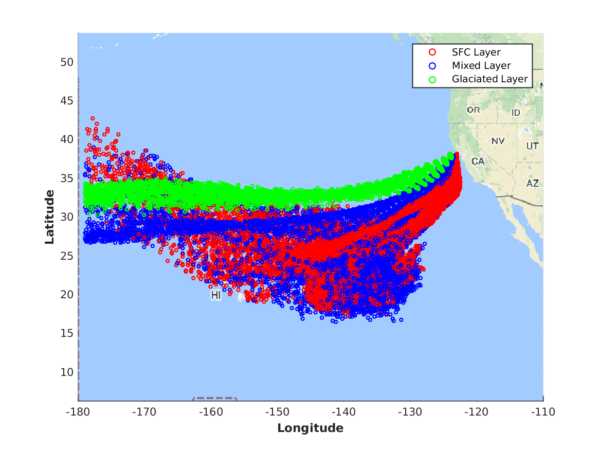Data from: Contrasting Local and Long-Range-Transported Warm Ice-Nucleating Particles During an Atmospheric River in Coastal California, USA
Data from: Contrasting Local and Long-Range-Transported Warm Ice-Nucleating Particles During an Atmospheric River in Coastal California, USA
About this collection
- Extent
-
1 digital object.
- Cite This Work
-
Martin, Andrew C.; Cornwell, Gavin; Beall, Charlotte M.; Cannon, Forest; Reilly, Sean; Schaap, Bas; Lucero, Dolan; Creamean, Jessie; Ralph, F. Martin; Mix, Hari T.; Prather, Kimberly A. (2019). Data from: Contrasting Local and Long-Range-Transported Warm Ice-Nucleating Particles During an Atmospheric River in Coastal California, USA. UC San Diego Library Digital Collections. https://doi.org/10.6075/J05X274R
- Description
-
Abstract: Ice nucleating particles (INP) have been found to influence the amount, phase, and efficiency of precipitation from winter storms, including atmospheric rivers. Warm INP, those that initiate freezing at temperatures warmer than -10 C, are thought to be particularly impactful because they can create primary ice in mixed-phase clouds, enhancing precipitation efficiency. The dominant sources of warm INP during atmospheric rivers, the role of meteorology in modulating transport and injection of warm INP into atmospheric river clouds, and the impact of warm INP on mixed-phase cloud properties are not well-understood. Time-resolved precipitation samples were collected during an atmospheric river in Northern California, USA during winter 2016. Precipitation was collected at two sites, one coastal and one inland, that are separated by less than 35 km. The sites are sufficiently close that airmass sources during this storm were almost identical, but the inland site was exposed to terrestrial sources of warm INP while the coastal site was not. Warm INP were more numerous in precipitation at the inland site by an order of magnitude. Using FLEXPART dispersion modelling and radar-derived cloud vertical structure, we detected influence from terrestrial INP sources at the inland site, but did not find clear evidence of marine warm INP at either site. We episodically detected warm INP from long-range transported sources at both sites. By extending the FLEXPART modelling using a meteorological reanalysis, we demonstrate that long-range transported warm INP are observed only when the upper tropospheric jet provided transport to cloud tops. Using radar-derived hydrometeor classifications, we demonstrate that hydrometeors over the terrestrially-influenced inland site were more likely to be in the ice phase for cloud temperatures between 0 C and -10 C. We thus conclude that terrestrial and long-range transported aerosol were important sources of warm INP during this atmospheric river. Meteorological details such as transport mechanism and cloud structure were important in determining warm INP source strength and injection temperature, and ultimately the impact of warm INP on mixed phase cloud properties.
- Scope And Content
-
This data set contains laboratory analyses, modeling, meteorological and radar analyses presented in the publication.
- Creation Date
- 2016-03-05 to 2018-05-01
- Date Issued
- 2019
- Principal Investigators
- Co Principal Investigators
- Contributors
- Funding
-
NSF award AGS-145147, NSF award AGS-1632913, USACE award W912HZ-15-2-0019
- Topics
Format
View formats within this collection
- Identifier
-
Identifier: Dolan Lucero: https://orcid.org/0000-0001-8469-7180
Identifier: Gavin Cornwell: https://orcid.org/0000-0002-4774-1282
Identifier: Jessie Creamean: https://orcid.org/0000-0003-3819-5600
Identifier: Kim Prather: https://orcid.org/0000-0003-3048-9890
- Related Resource
- Martin, A. C., Cornwell, G., Beall, C. M., Cannon, F., Reilly, S., Schaap, B., Lucero, D., Creamean, J., Ralph, F. M., Mix, H. T., and Prather, K.: Contrasting local and long-range-transported warm ice-nucleating particles during an atmospheric river in coastal California, USA, Atmos. Chem. Phys., 19, 4193-4210. 2019. https://doi.org/10.5194/acp-19-4193-2019
Primary associated publication
 Library Digital Collections
Library Digital Collections
